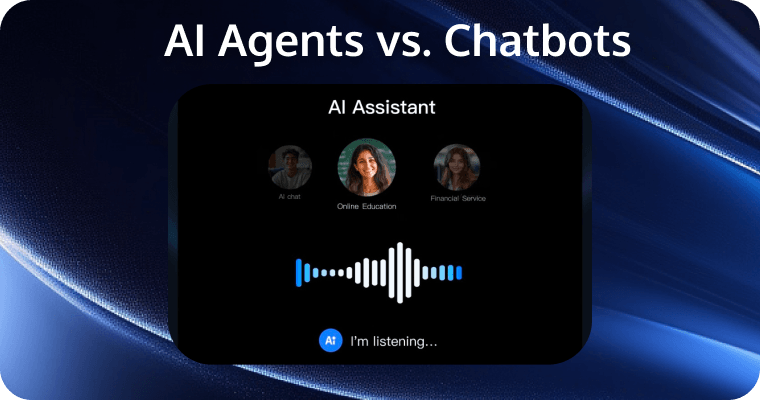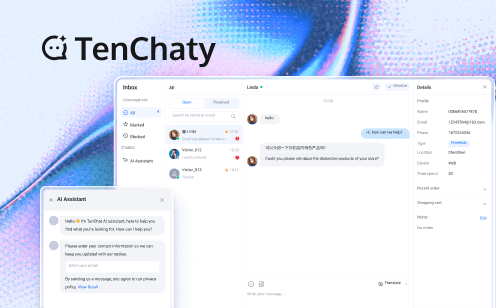
The world of artificial intelligence is brimming with exciting advancements, and two terms consistently dominate the conversation: AI agents and chatbots. While often used interchangeably, these technologies are distinct in their capabilities and potential applications. Understanding their differences is crucial for businesses looking to leverage AI to enhance their communication strategies.
Why Choose Tencent RTC for Conversational AI?
Looking to build a powerful, no-code AI Voice Assistant? Tencent RTC is your ultimate solution! With its unmatched versatility, ease of use, and cutting-edge features, Tencent RTC makes implementing Conversational AI a breeze. Here’s why it stands out:

1. Seamless Integration with Multiple AI Services
Tencent RTC supports integration with a wide range of STT, LLM, and TTS providers, including Azure, Deepgram, OpenAI, DeepSeek, Minimax, Claude, Cartesia, Elevenlabs and more. This flexibility allows you to choose the best services for your specific use case. When the LLM provider chooses OpenAI, any LLM model that provides OpenAI-compatible API endpoints is supported here, including Claude and Google Gemini.
2. No-Code Configuration
Tencent RTC simplifies the setup process with a user-friendly interface, enabling you to Configure Conversational AI in just a few minutes. No extensive coding knowledge is required, making it accessible to everyone.
3. Real-Time Interruption Support
Users can interrupt the AI's response at any time, enhancing the fluidity and naturalness of conversations.
4. Advanced Features
AI Noise Suppression: Ensures clear audio input, even in noisy environments.
Latency Monitoring: Tracks real-time performance to optimize conversation flow, including LLM latency and TTS latency.
Switch Providers on the Fly: Without ending the conversation, you can modify the interruption duration, or switch between different LLM and TTS providers (and voice IDs) to experiment with various configurations.
5. Multi-Platform Integration
If you like, Tencent RTC also supports local development and deployment across Web, iOS, and Android platforms, providing flexibility for diverse applications
Ready to see it in action? Watch this video or follow the tutorial to start building your AI Voice Assistant today!
Chatbots: The Conversational Interface
Chatbots are essentially automated conversational interfaces designed to simulate human-like interactions. They operate on pre-programmed rules and decision trees, responding to specific keywords and phrases with pre-defined answers. Think of them as sophisticated interactive FAQs.
Examples:
Customer service chatbots: Answering common questions about products or services, resolving simple issues.
E-commerce assistants: Guiding customers through product selection, providing recommendations.
Appointment schedulers: Booking appointments, sending reminders.
AI Agents: The Proactive Problem Solvers
AI agents, on the other hand, represent a significant leap forward. They are goal-oriented systems capable of understanding context, learning from interactions, and taking independent actions to achieve desired outcomes. They leverage machine learning and natural language understanding to engage in more dynamic and complex conversations.
Examples:
Personalized learning assistants: Adapting to individual student needs, providing tailored learning materials.
Proactive customer support agents: Anticipating customer needs, offering solutions before issues escalate.
Virtual travel agents: Planning personalized itineraries, making real-time adjustments based on user preferences and unforeseen circumstances.
Key Differences: A Closer Look
Reimagining Communication with AI
The distinction between chatbots and AI agents has profound implications for the future of communication. Here's how:
Beyond Basic Support: Integrating AI agents into cloud platforms can transform customer service from reactive problem-solving to proactive issue prevention. Imagine AI agents monitoring system performance, identifying potential issues, and automatically alerting users with solutions before disruptions occur.
Hyper-Personalized Experiences: AI agents can analyze user data, preferences, and past interactions to deliver highly personalized experiences within cloud applications. This could range from customized learning pathways in educational platforms to tailored content recommendations in entertainment services.
Streamlined Workflows: AI agents can automate complex tasks, freeing up human agents to focus on more strategic initiatives. For instance, an AI agent could manage meeting scheduling, travel arrangements, and resource allocation, significantly boosting team productivity.
The Future is Intelligent and Conversational
The future of communication is intelligent and conversational. While chatbots will continue to play a role in automating basic tasks, AI agents represent the next frontier, offering a powerful combination of intelligence, proactivity, and personalization. By embracing these advancements, businesses can unlock new levels of efficiency, customer satisfaction, and competitive advantage.
As AI technology continues to evolve, we can expect even more innovative applications of AI agents within cloud platforms, further blurring the lines between human and machine interaction and ushering in a new era of intelligent communication.


